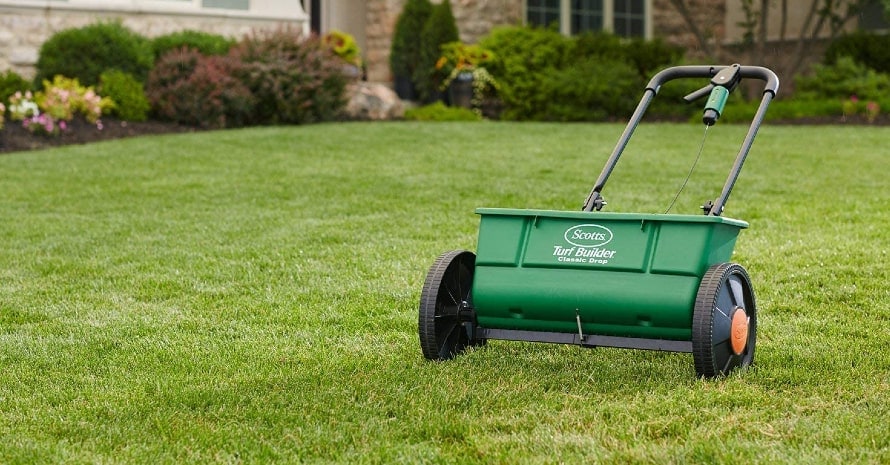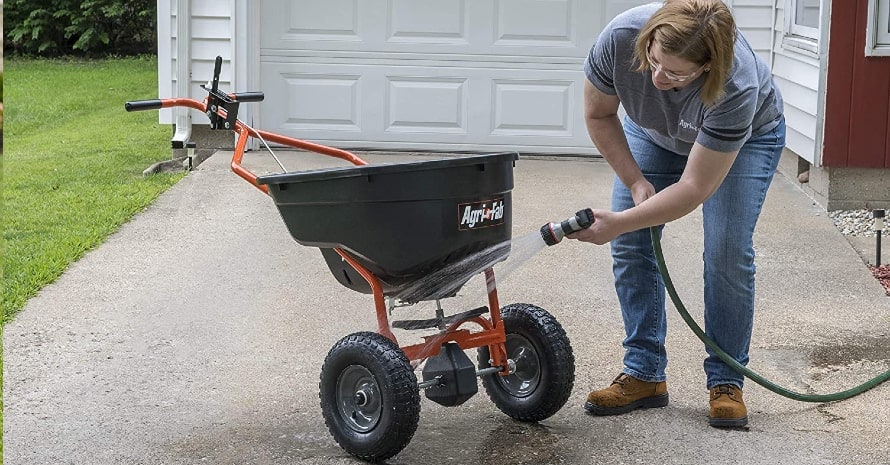Spreaders are a must when it comes to fighting off weeds, fertilizing the soil, planting flowers, and of course, keeping your lawn nice and pretty. But which is the winner in the broadcast vs. drop spreader stand-off? Well, a number of factors come into play: from the lawn size to your preferable yard routines.
The main difference between a drop and a broadcast spreader is that drop spreaders drop the fertilizer between the wheels, which lets you apply the product more precisely. Broadcast spreaders cover a large area ahead, which is very helpful for treating larger areas of land on which precision isn’t that important.
Both drop and broadcast spreaders have advantages and certain drawbacks. I will explain in which way they differ, which lawn spreader type you might need, how to use one and also give quick reviews of two worthy models from Amazon.
What is a Drop Spreader?

Let’s review this spreader type and learn its advantages/disadvantages.
Drop fertilizer-spreaders for lawns are the first type. The idea behind them is to use gravity and provide a more even spread of:
- Fertilizers;
- Herbicides;
- Plant seeds.
They will be deposited throughout your lawn more uniformly, going down through a row of holes. It guarantees that no patch of soil will be undoctored. As a result, you can manicure your lawn with the maximum precision and accuracy possible.
Types of drop spreaders
There are two types of them: manual and tow-behind. The main advantage of such a gizmo in the drop vs. broadcast spreader duel is that it allows controlling the flow-rate.
With it, you can avoid damaging nearby plants or flowers and also avoid polluting your neighbors’ lawn. A lot of drop spreaders even have a specific operational mode for urban areas.
So, the advantages of using a broadcast spreader are:
- It works great in the suburbs;
- It prevents wasting fertilizers and other supplies;
- Accurate spread pattern located right under the spreader;
- It helps avoid damaging the adjacent plants or littering the neighboring lawn.
And disadvantages:
- You will need more effort to cover the entire lawn/garden;
- It creates tiny lines in the soil when it runs out of materials.
As you can see, it’s a terrific appliance to keep your yard fine and dandy, especially if you’re not a professional or super zealous gardener.
Now let’s review the best affordable drop spreader on the market.
Scotts 76565 Turf Builder Classic Drop Spreader
Affiliate links and images placed from the Amazon Product Advertising API on 2025-10-16
Scotts Turf Builder is a drop spreader designed by the Scotts – a company that specializes in all sorts of lawn care products.
It is a durable spreader constructed from sturdy composite plastic. It also features a metal wheel axis, which enhances its longevity and makes the workflow smoother.
Turf Builder is pretty compact. It weighs 12,6 lbs and needs very little space in your garage since its dimensions are just 18 x 32 x 47 inches.
But despite its compactness, it has a nice 22-inch spreader that will do a nice job at covering your entire lawn with any necessary product: granular fertilizers, petunia seeds or herbicides to eliminate weeds that may threaten your yard like redroot pigweed, etc.
This is a readymade, out-of-the-box solution. To start working, all you need is to pull the thing out of the package, unfold and tighten the handles. It takes merely a few minutes, after which Turf Builder is ready for duty.
All in all, for its price it delivers a nice even spread. Operating the Turf Builder isn’t hard at all, and it doesn’t require a complex assemblage. The only problem it has is that you might need to cover the wheels with something like a thick foil to prevent them from collecting the stuff you spread.
What is a Broadcast Spreader?
You can either push a broadcast spreader with your own hands or use your lawnmower as an improvised tractor and attach the spreader to it. Other small vehicles that can move slow can also do the trick (any small ATV, basically).
So, the principal difference is that a broadcast spreader is equipped with a flywheel. On this flywheel, there’s a plate with a groove pattern. When put in motion, it spreads the materials it receives, so the soil will get an even amount of them.
Broadcast spreaders are a popular solution when it comes to covering a wide patch of soil. They are used in farming, professional gardening, landscaping, and so forth.
Types of broadcast spreaders
There aren’t any specific broadcast spreader sub-models. The only exception is that some can be used as a tow-behind solution, while others are primarily push spreaders.
The advantages of a broadcast spreader are:
- It’s perfect for big and open patches of land;
- It allows doing the job faster on a much wider area;
- You don’t have to worry about precision unlike with a drop spreader.
And disadvantages:
- It may not be ideal for a smaller lawn/garden.
As you can see, the broadcast type is significantly different from the previous one.
Let’s review one of the best broadcast spreaders that the market offers.
Agri-Fab 45-0462 Push Broadcast Spreader
Affiliate links and images placed from the Amazon Product Advertising API on 2025-10-16
Agri-Fab is a solid gadget made from heavy-duty materials. Its frame and handles are metal, unlike in the previous model. And the entire construction is carried by a pair of pneumatic tires.
It has a considerably large hopper, so you can use a whole caboodle of fertilizers or seeds per one session. The workflow is pretty nice as the rate of the spreader is stable and easy to calibrate. It has a special scale, which allows you to select the needed mode.
 Inside the hopper, there’s a clip that prevents cluttering. As for the spread itself, you can’t really complain: it’s steady, even, and ample. If your application area starts with at least about 1 acre, this gizmo is a perfect helper.
Inside the hopper, there’s a clip that prevents cluttering. As for the spread itself, you can’t really complain: it’s steady, even, and ample. If your application area starts with at least about 1 acre, this gizmo is a perfect helper.
To sum up, I think that Agri-Fab is a product of quality. Its design is thought-through – from the finish on the metal handles to the Jeep-like tires. It will save your time, effort, and also contribute to the bloom your garden will have.
Drop vs. Broadcast Spreader
So, a lot of homeowners deal with the drop or broadcast spreader dilemma. Here are a few tips on which to pick.
Lawn Size
How big your lawn, yard, or garden is? If it’s a small place, which you want to keep pedantically neat – the drop spreader must be your choice. It provides more precision and control.
But if your area is a whole latifundia with the size of nearly a golf course, the broadcast spreader is the best choice.
Quality
For occasional spreading, you can do fine with a cheaper plastic gizmo. But if you’re a dedicated landscaper, then a spreader made of stainless steel is a must. It offers a metal dispersion disk that provides more accuracy.
Price
Typically, a spreader costs around $80. Some are pricier as they are made of heavy-duty materials and will last for a much longer time, thanks to the solid metal frame.
How to use a broadcast spreader?
A short guide:
- Measure the area.
- Check the product package to pick the right amount of fertilizer, herbicide, etc., for the area.
- Check the distribution rate number on the package.
- Calibrate the rate dial of the spreader.
- Start at the end of your lawn, slowly moving the device.
- Make sure that the dispersion area overlaps the ‘processed’ strip by about 7-10 inches.
- Water the lawn until it’s damp to 1-inch depth.
Also, I wouldn’t recommend shaking your spreader if you’re running low on the materials as it may damage it or provoke clogging. Plus, never move it backward.
Besides, I’d recommend checking your soil for nitrogen, potassium, and phosphorus. As for the rest, utilizing a spreader isn’t complex at all.
Which spreader (drop or broadcast) do I need?
Generally, it depends on the size of the area and your personal goals. For example, if your lawn is really small, you don’t even need to decide between a drop spreader vs a broadcast spreader. A handheld spreader could be an optimal choice saving you a buck or two.
So, which is better: a broadcast or a drop spreader? If it’s a huge patch of soil like a football field – definitely a metal broadcast spreader like Agri-Fab. A small yard or an itty-bitty lawn – a drop spreader will work just fine.
Be a Lawn Shark
That sums up our spreader journey for today. Try one of the models I reviewed, follow my simple tips, and keep your lawn impeccable.
Which type of spreader do you prefer? Is a broadcast spreader really that good for big areas? Do you prefer to push it manually or use a tow-behind mode? Let us know in the comments!



